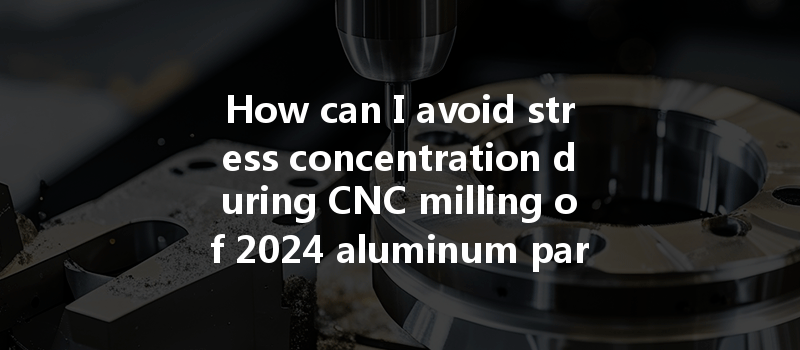: An Eye-Opening Fact
Did you know that nearly 80% of engineering failures can be traced back to the improper consideration of stress concentrations? This alarming statistic highlights the critical importance of understanding and mitigating stress concentration in machining processes, particularly when working with materials like 2024 aluminum, renowned for its strength and lightweight properties. In this blog post, we will navigate the fascinating world of CNC milling, focusing on effective techniques to avoid stress concentration during the machining of 2024 aluminum parts.
—
Understanding the Basics of Stress Concentration
Stress concentration refers to the accumulation of stress in a material at specific points or imperfections due to factors like geometric discontinuities, notches, or sharp corners. In CNC milling, particularly with high-strength materials such as 2024 aluminum, understanding and addressing these areas of concentrated stress is essential for the integrity and performance of the final product.
The Importance of 2024 Aluminum
2024 aluminum is a high-strength alloy primarily composed of aluminum, copper, and small amounts of other elements like manganese and silicon. Its significant strength-to-weight ratio makes it a popular choice for aerospace applications and structural components. However, its susceptibility to stress concentration necessitates careful machining practices.
—
Key Factors Contributing to Stress Concentration
To effectively mitigate stress concentration in CNC milling, it’s crucial to identify the primary factors contributing to it:
Strategies to Avoid Stress Concentration in CNC Milling of 2024 Aluminum
A. Use Fillets and Radii
Incorporating fillets and radii in the design can significantly reduce stress concentration. Sharp corners should be avoided, as they become sites for stress accumulation. Instead, using rounded transitions can help distribute stress more evenly.
B. Optimize Part Geometry
Avoid sudden changes in geometrical features. Gradual transitions in thickness and carefully designed cutouts can help minimize stress risers.
C. Stress Analysis
Utilize Finite Element Analysis (FEA) during the design phase. This tool helps identify and analyze stress concentration points, allowing engineers to make informed decisions about design modifications.
A. Optimize Cutting Speed
Choosing the right cutting speed is crucial. A higher cutting speed can reduce machining time, but it generates more heat, which can contribute to stress. An optimal cutting speed, tailored to the specific characteristics of 2024 aluminum, should be determined to balance efficiency with minimal thermal stress.
B. Control Feed Rate

A consistent and moderate feed rate can help manage the cutting forces applied to the material. Excessive feed rates may introduce additional stress and lead to tool wear or part deformation.
C. Depth of Cut and Overlapping Passes
Using a shallow depth of cut can minimize the amount of heat generated during machining. Overlapping passes can reduce the load on the material, leading to less stress concentration.
A. Use High-Quality Tools
High-quality, sharp cutting tools are crucial for achieving a smooth surface finish and reducing stress concentration. Worn or dull tools can create more friction, resulting in higher heat generation and residual stresses.
B. Proper Tool Geometry
Using tools with appropriate geometries can facilitate better chip removal and reduce cutting forces, which in turn minimizes stress concentration.
A. Use of Coolants/Lubricants
Employing a suitable coolant during the CNC milling of 2024 aluminum can significantly reduce the heat generated. This helps in maintaining a lower temperature in the cutting zone, minimizing thermal stress.
B. Air-Spray Cooling
In cases where traditional coolants may not be suitable, air-spray cooling can be an effective alternative. This method involves blowing air directly onto the workpiece during machining to keep temperatures low.
A. Stress Relieving Treatments
After machining, applying stress-relief processes can alleviate residual stresses in aluminum parts. Techniques such as thermal treatment or shot-peening can help restore material integrity.
B. Surface Treatments
Implementing surface treatments, such as anodizing, can improve the corrosion resistance of 2024 aluminum and provide a protective layer that enhances overall durability.
: Keeping Stress Under Control
Avoiding stress concentration during CNC milling of 2024 aluminum parts is a multifaceted process that combines design optimization, advanced machining techniques, appropriate tool selection, and post-processing treatments. By applying the strategies outlined in this blog post, engineers and machinists can significantly enhance the performance and reliability of their machined parts.
The importance of considering stress concentrations cannot be overstated; they are a critical factor in ensuring the longevity and functionality of components across various industries. As you navigate your next CNC machining project, remember that taking the time to analyze and implement these techniques will ultimately lead to higher-quality products and reduced instances of failure.
In conclusion, investing effort in understanding and avoiding stress concentration is vital to your machining success. By adopting these strategies, you’ll not only optimize your CNC milling process but also contribute to creating parts that stand the test of time. Remember, quality engineering starts with awareness and knowledge—so, let’s keep the conversation going about the importance of stress management in CNC machining!
—






